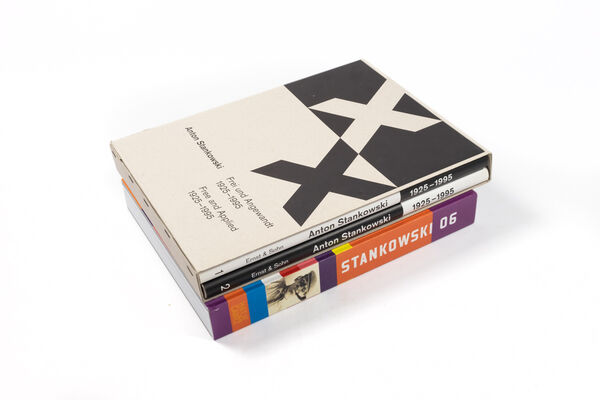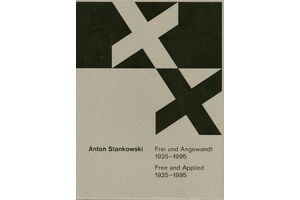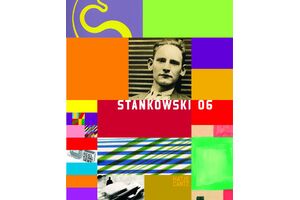Stankowski SET (2 vols.)
The book set consists of the following two books:
Anton Stankowski – Frei und Angewandt | Free and Applied
Stefan von Wiese (ed.). Ernst & Sohn 1996. Contributors Max Bense, Karl Duschek, Eugen Gomringer et al. Text: English, German. 519 pages, illustrated throughout. 25,5 x 34,5 cm. 3200 g. Cloth in slipcase with dust jacket. 9783433023709. RRP 125 €
Stankowski 06. Aspekte des Gesamtwerks | Aspects of his oeuvre
Ulrike Gauss, Stankowski-Stiftung (ed.). Exhib'publication. Staatsgalerie Stuttgart. Hatje Cantz 2006. Contributors Karl Duschek, René Grohnert, Hans Heinz Holz. Text in English, German. 408 pages, 1019 ills. 24,6 x 32,0 cm. 2755 g. Hardcover. 9783775717434. RRP 58 €
In his multifaceted artistic activity, Anton Stankowski (1906–1998) always approached his work in terms of the overall design.
As a decorative painter influenced by the Bauhaus and a comrade-in-arms of the Concrete artists in Zurich, he began to concentrate on fundamental visual elements in the late 1920s. At the same time, his masterly, abstract photographs, clever advertising graphics, and remarkable company logos were outstanding examples of visualization in the applied arts.
In the post-war years, besides his work for SEL, the Süddeutscher Rundfunk, and the Deutsche Bank, he developed a formal theory of design and also produced many paintings and high-quality prints.
The painter, photographer and commercial artist Anton Stankowski was born in 1906 in Gelsenkirchen, Germany. The basic concepts for his work developed out of the context of the 1920s. Lasting impressions were made on him especially by the New Objectivity, the Russian avant-garde, the Stijl movement, and the theoretical concepts of the Bauhaus. Stankowski was a dedicated proponent of the unity of free and applied art. For the field of commercial art, this approach logically entails the most demanding of artistic expectations. In advertising, he utterly renounces decorative elements and concentrates, in the visual realization of the information to be conveyed, on objective and compressed representation.
In his photography, this approach leads to the nearing of reality in an immediate form of presentation befitting this medium. Stankowski's street scenes created at the end of the 1920s clearly reveal the demands he imposed in this respect. Stankowski is considered a predecessor of the "Züricher Konkrete," and of the "Neue Fotografie." These movements turned away from stylized artistic photography as it had been cultivated by conservative photographers since the beginning of this century.
Commercial art and photography, however, are not the only fields in which Stankowski has become involved. He has increasingly dedicated himself to painting and has shown his works in a number of exhibitions since the 1970s. His earliest paintings date from about 1925.
Anton Stankowski – Frei und Angewandt | Free and Applied
Stefan von Wiese (ed.). Ernst & Sohn 1996. Contributors Max Bense, Karl Duschek, Eugen Gomringer et al. Text: English, German. 519 pages, illustrated throughout. 25,5 x 34,5 cm. 3200 g. Cloth in slipcase with dust jacket. 9783433023709. RRP 125 €
Stankowski 06. Aspekte des Gesamtwerks | Aspects of his oeuvre
Ulrike Gauss, Stankowski-Stiftung (ed.). Exhib'publication. Staatsgalerie Stuttgart. Hatje Cantz 2006. Contributors Karl Duschek, René Grohnert, Hans Heinz Holz. Text in English, German. 408 pages, 1019 ills. 24,6 x 32,0 cm. 2755 g. Hardcover. 9783775717434. RRP 58 €
In his multifaceted artistic activity, Anton Stankowski (1906–1998) always approached his work in terms of the overall design.
As a decorative painter influenced by the Bauhaus and a comrade-in-arms of the Concrete artists in Zurich, he began to concentrate on fundamental visual elements in the late 1920s. At the same time, his masterly, abstract photographs, clever advertising graphics, and remarkable company logos were outstanding examples of visualization in the applied arts.
In the post-war years, besides his work for SEL, the Süddeutscher Rundfunk, and the Deutsche Bank, he developed a formal theory of design and also produced many paintings and high-quality prints.
The painter, photographer and commercial artist Anton Stankowski was born in 1906 in Gelsenkirchen, Germany. The basic concepts for his work developed out of the context of the 1920s. Lasting impressions were made on him especially by the New Objectivity, the Russian avant-garde, the Stijl movement, and the theoretical concepts of the Bauhaus. Stankowski was a dedicated proponent of the unity of free and applied art. For the field of commercial art, this approach logically entails the most demanding of artistic expectations. In advertising, he utterly renounces decorative elements and concentrates, in the visual realization of the information to be conveyed, on objective and compressed representation.
In his photography, this approach leads to the nearing of reality in an immediate form of presentation befitting this medium. Stankowski's street scenes created at the end of the 1920s clearly reveal the demands he imposed in this respect. Stankowski is considered a predecessor of the "Züricher Konkrete," and of the "Neue Fotografie." These movements turned away from stylized artistic photography as it had been cultivated by conservative photographers since the beginning of this century.
Commercial art and photography, however, are not the only fields in which Stankowski has become involved. He has increasingly dedicated himself to painting and has shown his works in a number of exhibitions since the 1970s. His earliest paintings date from about 1925.
More books from Anton Stankowski view all



